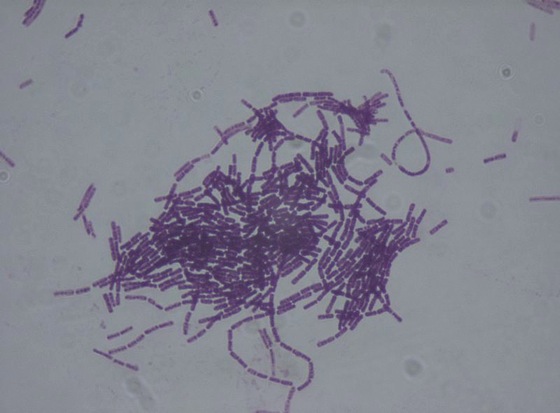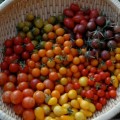 Garden Vocabulary: Bacillus thuringiensis
Garden Vocabulary: Bacillus thuringiensis
Gardener’s will often come across mention of Bacillus thuringiensis or BT as it is commonly called. It is a bacteria and biological pesticide that is often used in organic farming and gardening as it does not have many of the environmental and human side effects as other chemically-derived pesticides. It is most commonly used to control caterpillars of several garden pest including cabbage worms and tomato hornworm. My reading shows that there is some concern over side effects of using BT and the Wikipedia article has an extensive and well cited article on BT.
What can you share about this Garden Vocabulary entry? Help educate us all in the comments!

Bacillus thuringiensis (or Bt) is a Gram-positive, soil-dwelling bacterium, commonly used as a biological pesticide; alternatively, the Cry toxin may be extracted and used as a pesticide. B. thuringiensis also occurs naturally in the gut of caterpillars of various types of moths and butterflies, as well on leaf surfaces, aquatic environments, animal feces, insect rich environments, flour mills and grain storage facilities.[1][2]
During sporulation, many Bt strains produce crystal proteins (proteinaceous inclusions), called δ-endotoxins, that have Insecticide action. This has led to their use as insecticides, and more recently to genetically modified crops using Bt genes. Many crystal-producing Bt strains, though, do not have insecticidal properties.[3]
B. thuringiensis was first discovered in 1901 by Japanese biologist Ishiwata Shigetane.[3] In 1911, B. thuringiensis was rediscovered in Germany by Ernst Berliner, who isolated it as the cause of a disease called Schlaffsucht in flour moth caterpillars. In 1976, Robert A. Zakharyan reported the presence of a plasmid in a strain of B. thuringiensis and suggested the plasmid’s involvement in endospore and crystal formation.[4][5] B. thuringiensis is closely related toB.cereus, a soil bacterium, and B.anthracis, the cause of anthrax: the three organisms differ mainly in their plasmids.[6]:34–35 Like other members of the genus, all three are aerobes capable of producing endospores.[1] Upon sporulation, B. thuringiensis forms crystals of proteinaceous insecticidal δ-endotoxins (called crystal proteins or Cry proteins), which are encoded by cry genes.[7] In most strains of B. thuringiensis, the cry genes are located on aplasmid (in other words, cry is not a chromosomal gene in most strains).[8][9][10]
Cry toxins have specific activities against insect species of the orders Lepidoptera (moths and butterflies), Diptera (flies and mosquitoes), Coleoptera (beetles), Hymenoptera (wasps, bees, ants and sawflies) and nematodes. Thus, B. thuringiensis serves as an important reservoir of Cry toxins for production of biological insecticides and insect-resistant genetically modified crops. When insects ingest toxin crystals, the alkaline pH of their digestive tract denatures the insoluble crystals, making them soluble and thus amenable to being cut with proteases found in the insect gut, which liberate the cry toxin from the crystal.[8] The Cry toxin is then inserted into the insect gut cell membrane, paralyzing the digestive tract and forming a pore.[11] The insect stops eating and starves to death; live Bt bacteria may also colonize the insect which can contribute to death.[8][11][12] Research published in 2006 has suggested the midgut bacteria of susceptible larvae are required for B. thuringiensis insecticidal activity.[13]
In 1996 another class of insecticidal proteins in Bt was discovered; the vegetative insecticidal proteins (Vip).[14][15] Vip proteins do not share sequence homology with cry proteins, in general do not compete for the same receptors, and some kill different insects than do cry proteins.[14]
In 2000, a novel functional group of Cry protein, designated parasporin, was discovered from non-insecticidal B. thuringiensis isolates.[16] The proteins of parasporin group are defined as Bacillus thuringiensis and related bacterial parasporal proteins that are non-hemolytic but capable of preferentially killing cancer cells.[17] As of January 2013, parasporins comprise six subfamilies (PS1 to PS6).[18] — Wikipedia
- Annual
- Parterre
- Sepal
- Latin Botanical Epithets – Augustifolia
- Bolting
- Soil pH
- Leaf Arrangement
- Nitrogen Fixaton
- Stoma
- Parasite/Parasitism
- Xeriscaping
- Deadhead/Deadheading
- Fungus
- Petal
- Fruit
- Cotyledon
- Epiphyte
- Humus
- Conifer
- Deciduous
- Hybrid/Hybridization
- Acclimatization/Acclimation
This Garden Vocabulary series seeks to introduce and explain to you — and in many cases, myself — words and terms associated with gardening. Please let me know if there are any terms you would like me to explore. You can leave your ideas in the comments section and we can learn together!






